The winner – Flodesk
Basic
In this comparison, Flodesk wins in four out of eleven categories. Four categories result in a tie, and in three categories, tinyEmails outperforms Flodesk. As you can see, the competition is tough. Continue reading to discover more about the strengths and weaknesses of tinyEmail vs Flodesk.
What Flodesk features are better than tinyEmail?
- Getting started experience
- Marketing automation features
- List-building capabilities
- Analytics
- Unconventional credit card approach
- Automation available for Shopify users only. Very basic.
- Form builder needs improvements
- Fewer insights available
Choosing the best email marketing tool can be challenging, with new choices constantly appearing. Two noteworthy newcomers in this space are tinyEmail and Flodesk.
Launched in 2021, tinyEmail takes a straightforward approach to email marketing, offering a robust email builder and an extensive template library.
Flodesk, introduced in 2019, was created by and for creators. Like tinyEmail, it’s acclaimed for its user-friendly, visually pleasing email editor, simplifying the process of crafting attractive email campaigns.
That said, there are a few differences between the features offered by both tools and their pricing models.
This tinyEmail vs Flodesk comparison will discuss these differences, evaluating aspects like automation, segmentation, customer support, and more.
Read on to make an informed choice for your business.
tinyEmail vs Flodesk: Quick overview
tinyEmail enjoys a remarkable rating of 4.7/5 on the Shopify App Store. Users often commend its user-friendly interface and responsive support team.
In contrast, Flodesk isn’t currently listed as an email marketing app on the Shopify App Store. However, users frequently praise its advanced email builder and stylish templates.
Another advantage of Flodesk is its cost-effective flat-rate pricing, which is particularly beneficial for businesses with extensive subscriber lists.
So which tool’s ideal for your needs — tinyEmail or Flodesk?
Before diving into a detailed comparison, let’s take a quick look at their key features.
After examining the table, it’s clear that both tools provide similar features. Yet, a closer inspection reveals several other differences between the two.
So, let’s delve deeper into the specifics.
tinyEmail vs Flodesk: Feature by feature
Comparing tools helps you understand their pros and cons, making it easier to see if a particular software fits your needs.
In this section, we’ll evaluate both platforms on various aspects and declare a winner for each.
Ease of getting started
Both Flodesk and tinyEmail are recognized for their easy signup processes. But how do they compare? Let’s find out.
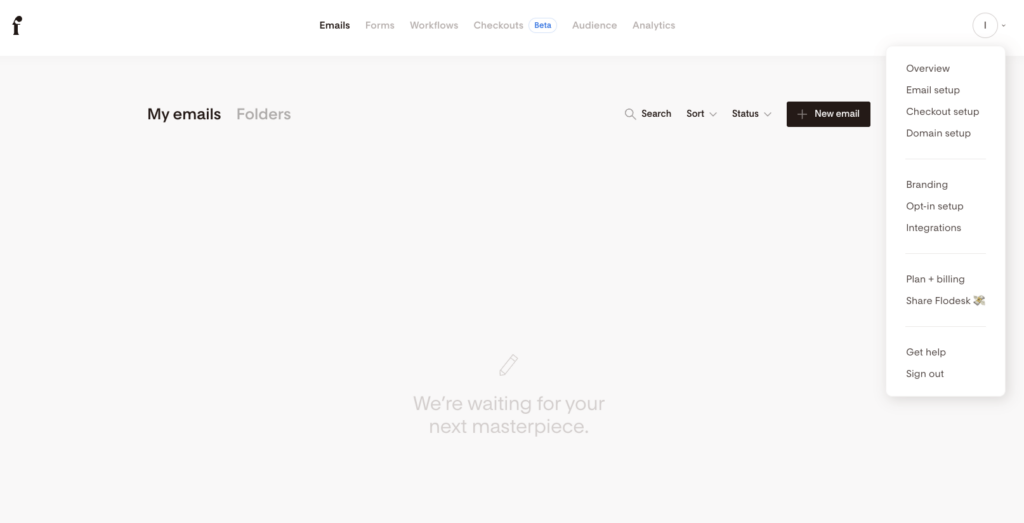
Flodesk excels in simplicity with its minimalistic interface, making navigation a breeze. Setting up the platform, changing the sender’s email, and accessing essential features are all straightforward tasks.
A bonus is that signing up for Flodesk’s free trial requires no credit card information. On the other hand, tinyEmail has a slightly different approach here.
When initiating their free trial, tinyEmail requires you to provide credit card information. There’s no option to choose a free plan; only paid plans are presented.
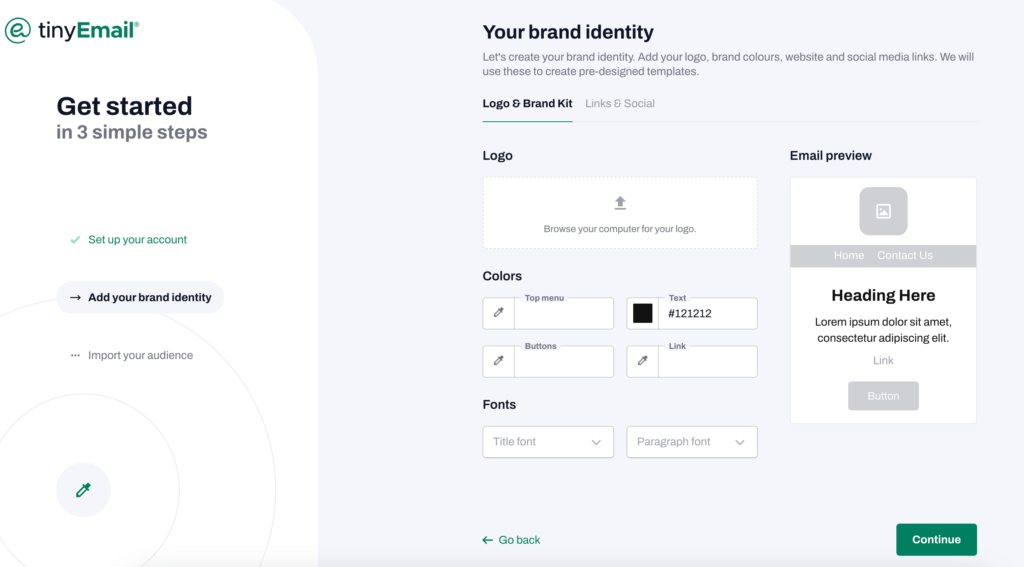
tinyEmail later emails users an alternative sign-up option without credit card details. This approach might appear less transparent and raised some concerns on our end.
In terms of usability, tinyEmail aligns closely with Omnisend and MailerLite, providing an intuitive user experience with a modern and clear design.
It offers a 7-day free trial with seamless account verification and user-friendly settings. However, it’s important to mention that tinyEmail’s signup process requires more initial information than some other platforms.
It’s also worth noting that neither of these platforms offers guidance or a getting-started wizard. This approach may suit users who prefer to explore the platforms at their own pace.
Flodesk takes the lead with its transparent approach and clean design.
Building an email campaign
Both Flodesk and tinyEmail excel in this aspect, but which is superior? Let’s explore and compare.
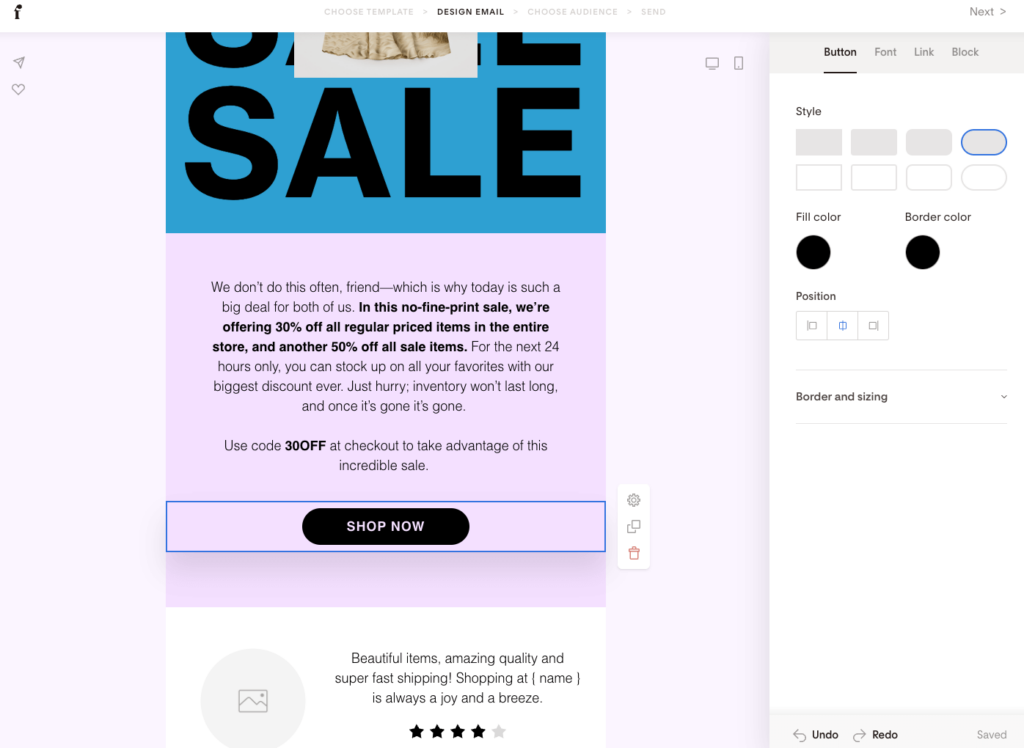
Flodesk supports regular campaigns and automated emails. Its email builder offers:
- All standard email elements, including images, lines, menu bars, etc
- A library of stunning templates
- The option to change image opacity within the editor
- Email previews for mobile and desktop
- 100+ premium fonts
- Free stock images and GIFs from Unsplash and GIPHY, respectively
Although Flodesk’s email design builder has a distinctive look, it includes all the necessary email components. An interesting feature is the ability to embed images directly from Instagram easily.
Sweetening the deal is Flodesk’s email wizard, which leads you through a straightforward process: template selection, design editing, and the addition of campaign details such as the subject line, recipients, and sending time.
With tinyEmail, you can also send only regular and a few types of automated campaigns. But just like Flodesk, the rest of tinyEmail’s features are pretty impressive.
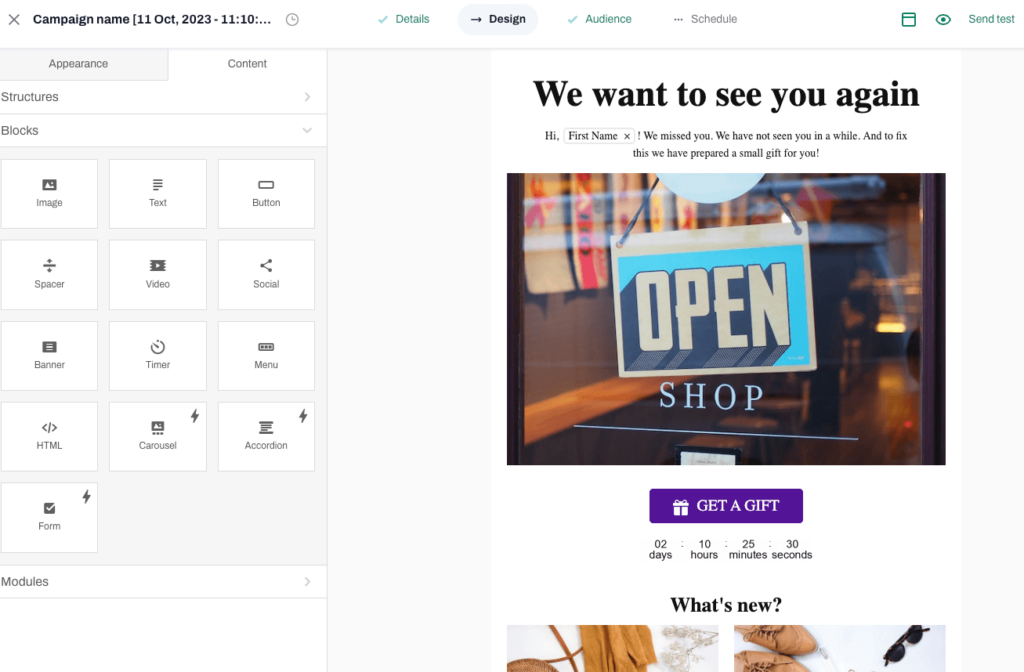
Firstly, you can choose from a wide selection of 300+ templates. Furthermore, tinyEmail offers remarkable flexibility with elements such as timers and image carousels.
You’ll also find a stock image library for enhancing visuals. Additionally, tinyEmail provides an AI text generator for crafting email copy.
Finally, there are numerous fonts and styles for customization, making it a versatile choice for your email marketing campaigns.
As far as personalization goes, both Flodesk and tinyEmail use merge tags.
Before we declare the winner of this round, let’s address some drawbacks. Both platforms lack ecommerce-specific features such as product recommenders or product content blocks.
Also, in tinyEmail, some templates easily adjust to your brand’s design, while others don’t. We found this to be a bit odd.
This round ends in a draw. Whether you choose tinyEmail or Flodesk, you’ll benefit from a robust email builder.
Marketing automation
The automation features offered by both tinyEmail and Flodesk are quite basic.
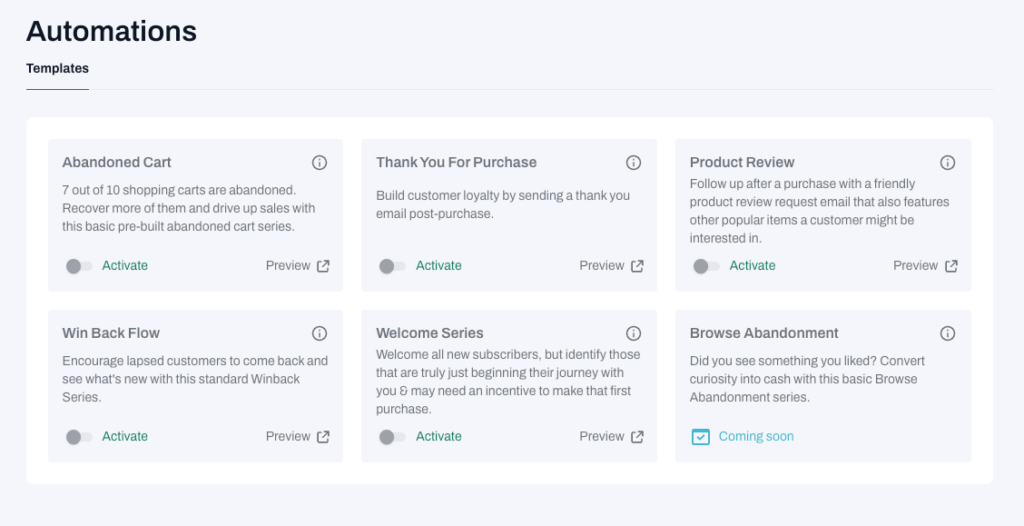
In tinyEmail, your choices for prebuilt workflows are limited, focusing primarily on scenarios like abandoned carts, thank-you messages, and product reviews.
Unfortunately, these are exclusively for Shopify users, and you have no flexibility to make any adjustments to them. Your only option is to activate and utilize these workflows as they come.
On the other hand, Flodesk provides a bit more flexibility with options such as welcome sequences, sales sequences, nurture sequences, and lead magnet delivery automation. You can also edit the text to better suit your specific needs.

The trigger options in Flodesk are limited to subscriber segment entry. However, this is still an advantage over tinyEmail, which lacks triggers altogether.
Whether you opt for Flodesk or tinyEmail, your automation options are confined to email. Neither platform supports integration with other marketing channels. What’s more, they both lack advanced features such as conditional splits and specific ecommerce functionalities.
Flodesk wins in this round as its workflows are suitable for non-Shopify users, and it provides at least one trigger option. However, the automation part is basic on both platforms and suitable for basic needs only.
Signup forms and landing pages
tinyEmail vs Flodesk: Which platform offers better list-building capabilities?

Flodesk offers a range of form types, including popup, inline, and full landing page forms. It also allows you to display a thank-you message or redirect subscribers after signup.
As far as visuals are concerned, users can choose from 40+ customizable templates. To further boost design and appeal, there’s also the option to add Unsplash images.
Like Flodesk, tinyEmail supports various signup forms like embedded forms, popups, and flyouts. However, customization options are limited, and the editor isn’t so intuitive. For instance, we found that adding or changing suggested images is pretty challenging.
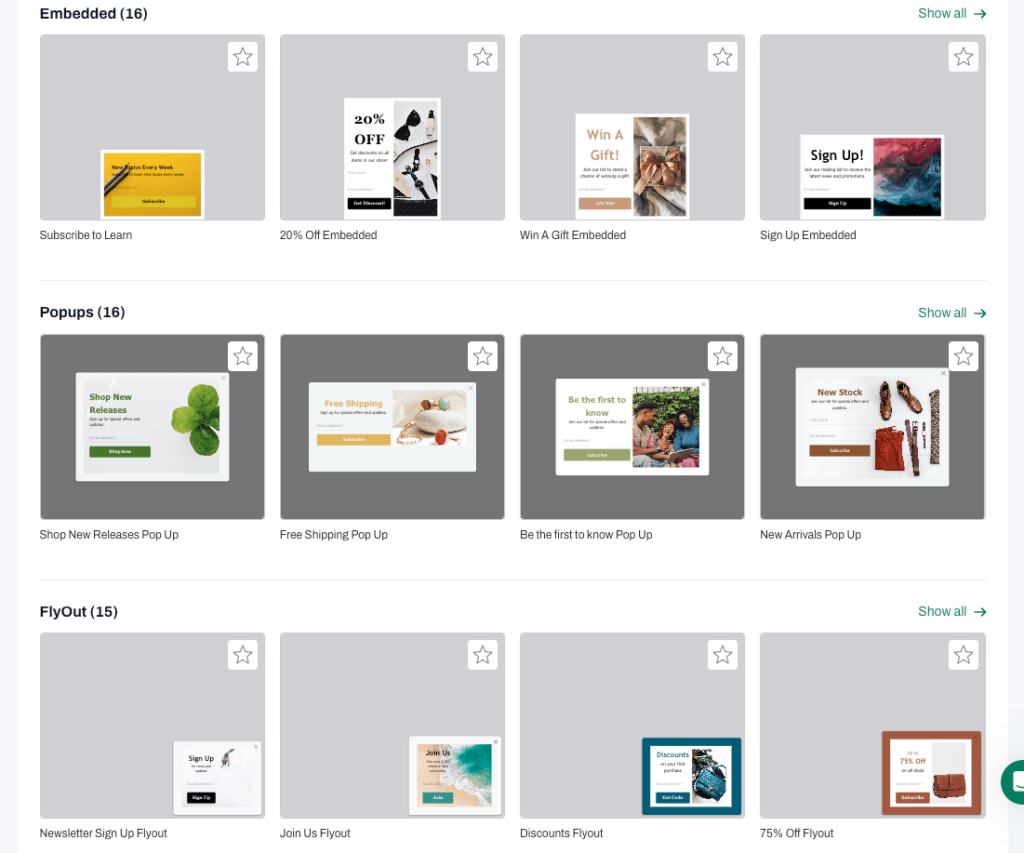
Moreover, tinyEmail lacks landing pages. This can be a significant drawback, especially for ecommerce businesses.
On the contrary, Flodesk does provide a landing page builder, with templates for different purposes such as:
- Selling digital products
- Sharing educational content
- Offering freebies
- Creating a checkout page
However, Flodesk refers to landing pages as ‘checkouts,’ which is unusual.
It’s worth noting that both platforms have certain limitations. For instance, they may not launch forms on your website automatically, and their popup settings are somewhat restricted.
List management
Managing lists on tinyEmail is pretty straightforward. The tool gives you useful information about where your subscribers are coming from. However, when it comes to diving deeper into audience insights, it falls a bit short.
Flodesk, on the other hand, opts for segments instead of the usual lists, but they work quite similarly. Importing contacts is a breeze, and we found that it’s in line with industry standards.
Flodesk is the clear winner of this round. It offers both signup forms and landing pages and also comes with greater customizability.
Segmentation
tinyEmail provides users with 15 pre-defined segments. However, it’s worth noting that only four of these are available with the Standard plan, with the remaining segments reserved for Pro plan users.
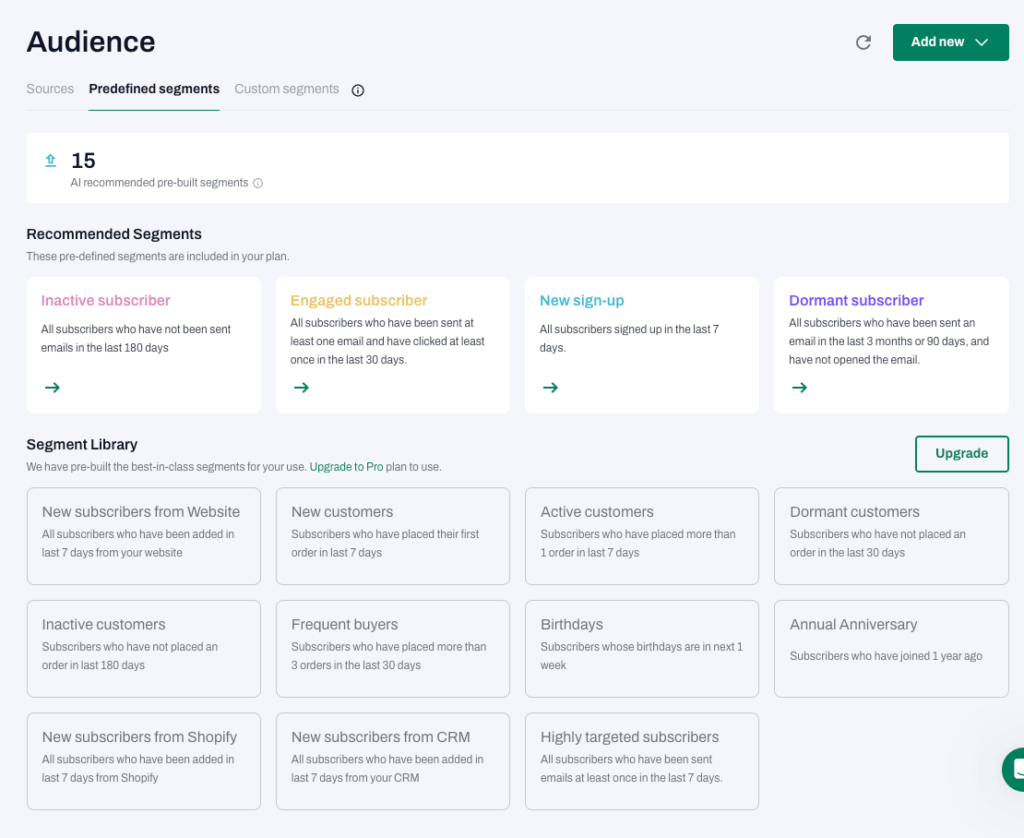
When it comes to segmenting your audience within tinyEmail, you can do so based on email engagement criteria. There are also segments relating to subscriber profile information, such as:
- Location
- Name
- Order count
- Most recent order
Overall, tinyEmail’s segmentation features look decent. That said, the tool lacks some of the advanced features that could be particularly beneficial for ecommerce businesses.
For instance, you won’t find conditions based on on-site behavior or tags within this platform.
Flodesk’s segmentation isn’t particularly impressive either. Let’s explore what it can do, though.

Unlike the traditional list approach, Flodesk relies on segment creation through the application of filters. These filters cover various aspects, including the activity date, source, and belonging to other segments or data fields.
But it’s disappointing that Flodesk doesn’t feature common segmentation criteria like demographics and email activity.
Moreover, the functionalities seem pretty basic, and navigation isn’t so smooth. For instance, while there is a feature for tagging subscribers, we were unable to locate it.
It’s a tie since both platforms have room for improvement.
Analytics
tinyEmail vs Flodesk: Who takes the lead in analytics?
Flodesk offers an Analytics tab with five distinct sections, providing detailed data on subscribers, emails, forms, workflows, and checkouts.
Here are the key metrics users can track:
- Automation: Data such as active subscribers, entries, completions, open rates, click rates, and unsubscribe rates.
- Email campaigns: Insights into email engagement, opens, and clicks, broken down by the device used.
- Checkouts: Information on the number of visitors, orders, and total sales.
To present this data, Flodesk uses various visualization tools. These include metric cards, bar charts, comparative metric charts, pie charts, heat maps, and tables.
tinyEmail’s analytics are a lot more basic. You can monitor metrics like opens, clicks, and delivery rates. The tool also enables users to track the evolving performance trends of their email campaigns.
Once again, Shopify store owners enjoy more features on tinyEmail. They can easily track email campaign sales and see how many times their email links were clicked.
Nonetheless, when it comes to analytics, both Flodesk and tinyEmail have limitations. For instance, they provide minimal ecommerce insights and geolocation reports.
Flodesk wins by a slight margin. It provides a few checkout-related metrics and slightly more advanced features.
Customer support
tinyEmail provides chat and email support to both free and paid plan users 24/7.
A positive aspect is that tinyEmail provides onboarding calls, frequently resolving many inquiries right at the start of your journey.
Flodesk’s customer support options look restricted. Live chat and phone support are notably absent, leaving only email support available in the US between 6 am and 6 pm Eastern Time.
Thankfully, both tools provide various online resources and tutorials for those who don’t mind a DIY approach. However, relying solely on these materials may not be as effective as receiving direct support, potentially leading to unanswered queries.
That said, we ought to make special mention of Flodesk University, which offers complimentary video courses on email marketing. The best part is that these courses are accessible to everyone without necessitating signup or registration.
tinyEmail emerges as the winner, as it provides chat and phone support in addition to email assistance.
Integrations
Flodesk vs tinyEmail: Which platform performs better in the integrations department?
Currently, Flodesk offers direct integration exclusively with Shopify, Instagram, Interact and Marvelous. On the plus side, it does have integration with Zapier and Pabbly. This allows you to establish connections with thousands of other applications.
tinyEmail also has native integrations, in addition to its compatibility with Zapier. Let’s take a closer look at them:
- Email migration: Effortlessly transition from Mailchimp, Campaign Monitor, Drip, Constant Contact, Klaviyo, and MailerLite
- Ecommerce: Seamlessly integrate with Shopify, WooCommerce, Magento, and Volusion
- CRM: Integrates with Quickbooks, Zoho CRM, HubSpot, Salesforce, and more
- Forms: Supports OptinMonster and various other popular form services
- Payment Gateways: Compatible with Stripe and Paypal for streamlined transactions
- Connectors: Supports Pabbly for automation and data synchronization
tinyEmail wins, as it seamlessly integrates with both Zapier and a diverse array of native integrations.
Compatibility with other marketing channels
As of now, both Flodesk and tinyEmail are focused solely on email marketing and don’t integrate with other marketing channels.
That said, tinyEmail does have future plans to incorporate SMS marketing features.
This round is a tie as both Flodesk and tinyEmail are email-focused without other channels.
Generative AI
GenAI tools bring advanced AI insights to email marketing platforms, improving personalization and communication.
For Shopify businesses, tinyEmail has introduced a specialized product named “tinyAlbert.” This tool harnesses the power of GPT-4 AI to manage various aspects of their email marketing.
In essence, tinyEinstein functions as an AI marketing manager, performing tasks such as:
- Creating compelling emails for increased conversions
- Capturing website visitors as potential customers
- Automating marketing messages at strategic times
- Ensuring email delivery to inboxes
- Assisting in crafting persuasive email content
The only limitation is that this tool is exclusively available to Shopify users.
Flodesk, on the other hand, doesn’t offer any GenAI tools at the moment.
Naturally, tinyEmail is the winner of this round.
Price Comparison
Pricing is often a key consideration when it comes to picking the right email marketing software.
Before we determine the ultimate winner in this tinyEmail vs Flodesk comparison, we’ll thoroughly evaluate their free and paid plans. Throughout this assessment, we’ll consider both the costs and the features they offer.
Free plans comparison
tinyEmail provides a forever free plan, allowing users to send up to 15,000 emails to a subscriber list of up to 500 per month. Although the email-sending limit is generous, the features available are somewhat limited. Here’s a summary of what’s included:
- Signup forms and popups
- Automation emails
- AI subject line assistant
- Campaign analytics
- Limited sender identities
- Integrations
Also, recently, tinyEmail launched Shopify Pro plan which offers many features and is free for Shopify users.
While Flodesk doesn’t have a free plan, it does offer a generous 30-day free trial. During this period, you’ll have unrestricted access to all the tool’s capabilities.
Now, let’s examine the paid plans offered by both tools.
Paid plans comparison
We’d like to emphasize an important difference right at the beginning, as it is likely to simplify your decision-making process.
tinyEmail employs a tiered pricing model. This means pricing depends on the number of emails you want to send and the required features.
Conversely, Flodesk employs a flat pricing model. In essence, a fixed subscription fee grants access to all features, regardless of the number of subscribers or email-sending requirements.
Thus, the monthly pricing for both tools appears as follows:
Flodesk offers two distinct plans to cater to different business needs. The Email plan focuses solely on fulfilling email marketing needs.
Conversely, the Email & Checkout plan is tailored for businesses seeking both email marketing and ecommerce-specific functionalities. This plan includes supplementary features like discount codes, online payment capabilities, and checkout flows.
In terms of cost efficiency, Flodesk may serve as a fitting choice for expanding businesses. That said, it’s important to note that Flodesk’s features may not justify the initial price.
Much like Flodesk, tinyEmail provides two standard paid plans. It also offers an Enterprise plan, a customized option tailored for larger businesses.
If you value the flexibility to manage the size of your subscriber list, tinyEmail is an excellent choice. Conversely, if you prefer the benefit of unlimited emails, you might want to explore other tools. And if you want both, Flodesk might be the tool you need.
tinyEmail vs Flodesk: Which one wins?
Before declaring the ultimate winner, let’s review the features and pricing of tinyEmail vs Flodesk:
3.5
3.1
Up to 15,000 emails – $15
Up to 25,000 emails – $25
Up to 50,000 emails – $50
Up to 100,000 emails – $100
Flat-rate pricing model.
There are two plans based on the features you need, regardless of the number of subscribers.
Email plan – $38/month
Email & Checkout plan – $64/month
– Up to 500 subscribers
– Up to 15,000 emails
– Forms and popups
– Automation emails
– AI subject line assistant
– Limited sender identities
– Shopify Pro plan for Shopify users
– Paid plans only
– 30-day free trial
– Easy to signup and use
– Robust email builder
– A huge library of email templates
– Beautiful designs
– Very easy to use
– Clean interface and intuitive design
– Basic automation and reporting
– Advanced segmentation is missing
– Form builder should be improved
– Basic automation and segmentation features
– No live chat or phone support
– A/B tests missing
– Email marketing beginners
– Bloggers
– Non-profit organizations
– Bloggers
– Freelancers
– Educators
– Personal branding specialists
– Non-profit organizations
– Digital sellers
– Established ecommerce businesses
– Ecommerce businesses of any size
Choosing between tinyEmail vs Flodesk is challenging due to their similar features and weaknesses. Both excel in email design and offer extensive template libraries, but both fall short in marketing automation and segmentation.
However, there are a few notable distinctions. For example, tinyEmail is missing a landing page builder, while Flodesk lacks native integrations with other platforms. Additionally, their pricing models differ significantly.
If you prioritize a tool that disregards subscriber lists and email quotas, Flodesk is a good choice, albeit with relatively high starting prices. For basic needs and limited growth expectations, consider tinyEmail.
It’s essential to remember that many other tools provide more features for similar or lower prices than these two. And if you’re searching for tools with advanced ecommerce-focused capabilities, we highly recommend exploring GetResponse, Omnisend, or Klaviyo.
Read full reviews
Our team strives to be accurate and unbiased in reviewing email tools. However, we recognize that mistakes can happen, and it’s essential for us to stay up to date. If you come across any errors or things that need to be reviewed again, please let us know.





Leave a Reply